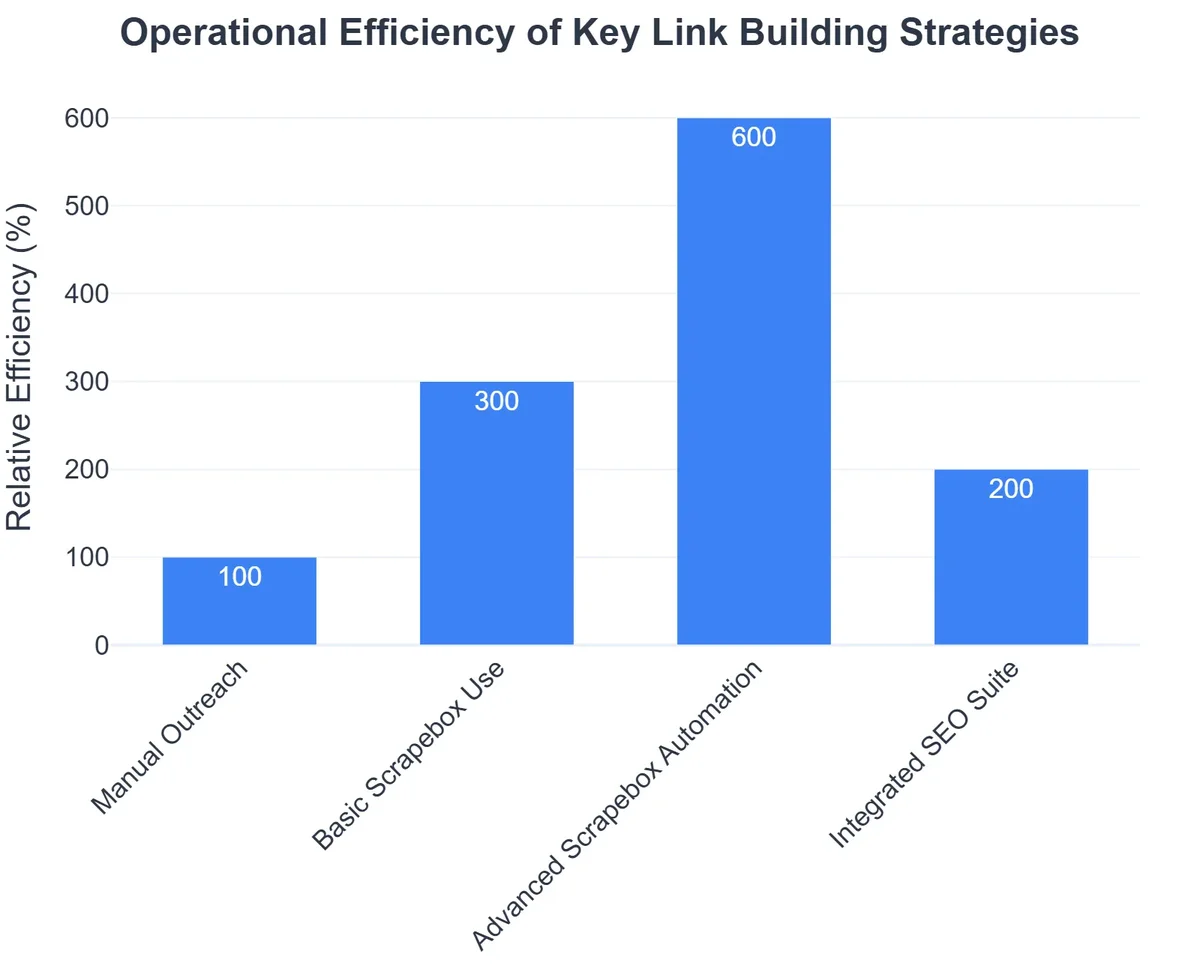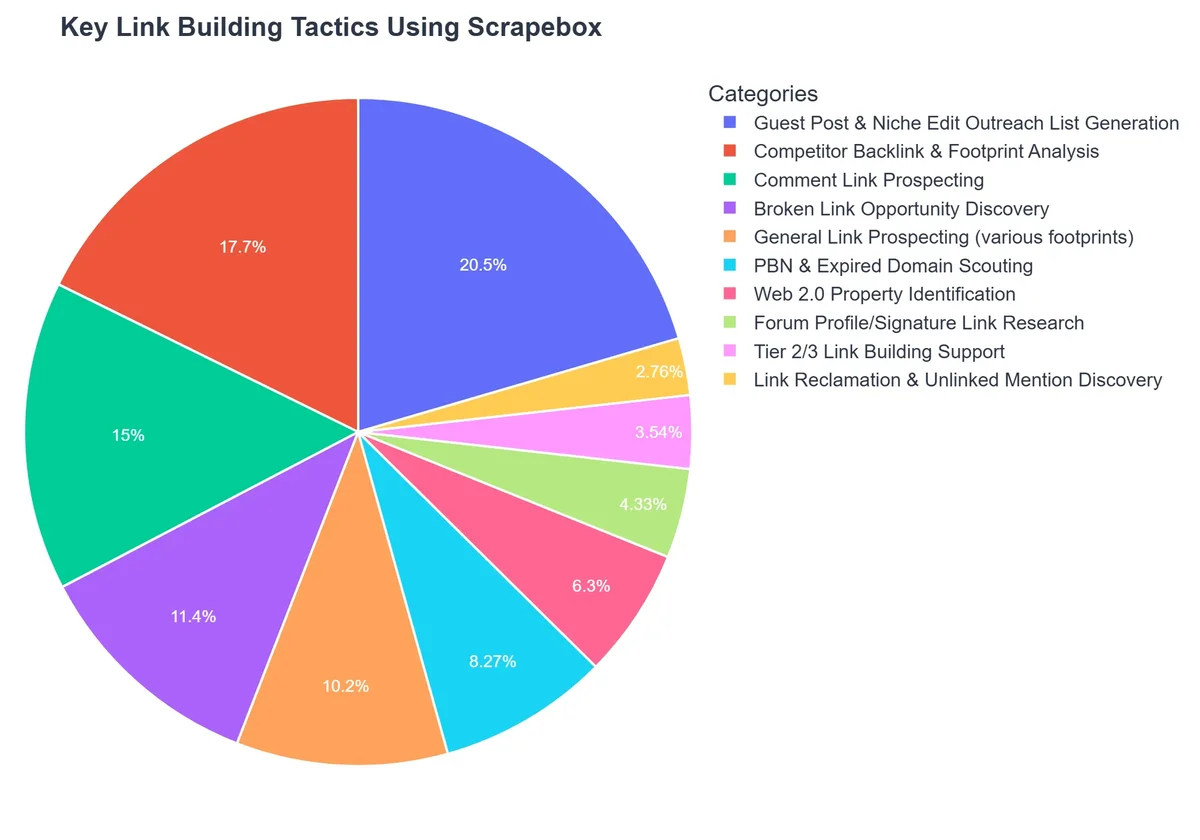Scrapebox for Link Building: A Comprehensive Guide
In the dynamic world of SEO, link building remains a cornerstone of digital marketing success. High-quality backlinks are powerful signals to search engines, indicating authority and trustworthiness, which in turn can significantly boost search rankings. While the landscape of link building has evolved, tools that provide efficiency and scale in prospecting and outreach remain invaluable. Among these, Scrapebox backlinks capabilities have long positioned it as a unique and versatile instrument in an SEO professional’s toolkit.
💡 Key Takeaways
- Scrapebox is a versatile tool for automating various link building tasks, from initial prospecting to competitor analysis.
- Proper setup, ethical usage, and the right proxies are crucial to leverage Scrapebox effectively without violating search engine guidelines.
- Beyond basic functions, Scrapebox can be used for advanced competitive research, content idea generation, and targeted outreach campaigns.
- While powerful, Scrapebox should be part of a broader, ethical link building strategy focusing on providing value and relevance.
“Scrapebox, when wielded responsibly, can be an invaluable asset for scaling link prospecting and identifying unique opportunities that manual methods often miss. It’s about smart efficiency, not shortcuts.”
— Isabella Hall, Lead Link Building Specialist
Known affectionately as the “Swiss Army Knife of SEO,” Scrapebox offers a suite of functionalities that, when used correctly, can streamline various stages of the link building process. From initial reconnaissance to targeted outreach, understanding how to harness Scrapebox’s power can give you a significant edge. However, like any powerful tool, it demands responsible and strategic application to avoid pitfalls and ensure positive results.
This comprehensive guide will delve deep into how Scrapebox can be leveraged for effective link building. We’ll explore its core features, detail strategic approaches, discuss best practices, and highlight the ethical considerations necessary for sustainable SEO growth. For a broader understanding of foundational SEO principles, consider our Link Building: The Ultimate Guide to Off-Page SEO pillar content.
In This Article
- → Scrapebox for Link Building: A Comprehensive Guide
- — 💡 Key Takeaways
- → What is Scrapebox? The ‘Swiss Army Knife’ of SEO
- → Core Scrapebox Features for Effective Link Building
- → Strategic Approaches to Link Building with Scrapebox
- — Comment Backlinks (The Old Way & How to Adapt)
- — Prospecting for Guest Posts & Resource Pages
- — Broken Link Building
- — Tiered Link Building
- → Best Practices and Ethical Considerations
- → Advanced Strategies and ‘Scrapebox YouTube’ Integration
- → Risks and Limitations of Using Scrapebox
- → Conclusion: Scrapebox – A Powerful Tool in the Right Hands
What is Scrapebox? The ‘Swiss Army Knife’ of SEO
Scrapebox is a desktop-based SEO tool that gained prominence for its immense versatility and automation capabilities. It’s not a one-trick pony; rather, it combines multiple functions crucial for various SEO tasks, including research, analysis, and, notably, link building. Unlike many cloud-based SEO platforms, Scrapebox offers unparalleled control and flexibility, allowing users to customize their operations extensively.
At its core, Scrapebox is designed to scrape (extract) data from websites based on user-defined queries and parameters. This data can range from URLs and email addresses to specific content snippets. While it’s often associated with automated commenting, its utility extends far beyond that, encompassing sophisticated prospecting, competitive analysis, and content research.
The strength of Scrapebox lies in its ability to process large volumes of data quickly, identify patterns, and provide actionable insights that would be incredibly time-consuming to gather manually. This efficiency is what makes it a staple for many experienced SEOs, particularly those engaged in large-scale link building campaigns.
Core Scrapebox Features for Effective Link Building
Scrapebox boasts an array of features that can be strategically employed for various link building tactics. Understanding each one’s role is key to maximizing its potential:

- Keyword Harvester: This powerful module allows you to generate massive lists of keywords based on initial seed keywords. These keywords are then used to find relevant websites, forums, blogs, and communities that might offer link opportunities. For instance, if you’re in the “digital marketing” niche, it can generate thousands of long-tail variations like “digital marketing tips,” “online advertising strategies,” etc.
- Comment Scraper: Perhaps Scrapebox’s most famous feature, the comment scraper, can crawl vast numbers of blogs and extract comment sections. This was historically used for automated comment posting, but its modern application is primarily for prospecting niche-relevant blogs for potential engagement, guest posting, or identifying moderated comment sections for legitimate contributions.
- Email Scraper: Once you’ve identified a list of potential link targets, the email scraper can extract contact email addresses from those URLs. This is invaluable for outreach efforts, whether for guest post pitches, broken link building, or resource page submissions.
- Proxy Harvester & Manager: Given the intensive scraping nature, using proxies is essential to avoid IP blocks. Scrapebox has built-in tools to harvest, test, and manage proxies, ensuring smooth and uninterrupted operation.
- Blog Analyzer: This feature allows you to analyze a list of URLs for various metrics, such as PageRank (though less relevant now), number of outbound links, and comment platform type, helping you prioritize targets.
- Link Checker: Before embarking on a broken link building campaign, Scrapebox’s link checker can quickly verify if links on a target page are indeed broken, saving significant manual effort.
- Addons/Plugins: Scrapebox’s extensibility through its various free and premium addons (e.g., Alive Checker, Backlink Checker, Social Account Scraper) significantly expands its capabilities, allowing it to adapt to evolving SEO needs.
Strategic Approaches to Link Building with Scrapebox
While Scrapebox can be used for automation, its true power in modern SEO lies in its ability to facilitate intelligent prospecting and outreach. Here’s how:
Comment Backlinks (The Old Way & How to Adapt)
Historically, Scrapebox was synonymous with automated blog commenting. In the past, this involved blasting comments with keywords and links across thousands of blogs. However, this tactic is now largely ineffective and can even be detrimental due to Google’s sophisticated spam detection. Modern use of the comment scraper involves:
- Niche-Relevant Prospecting: Use the comment scraper to find blogs relevant to your niche. Instead of mass commenting, identify high-quality blogs that allow legitimate, moderated comments.
- Engagement & Relationship Building: Engage authentically on these blogs, contributing valuable insights. Over time, this can lead to real connections and potential opportunities for higher-value links (e.g., guest posts).
Prospecting for Guest Posts & Resource Pages
This is where Scrapebox shines as a research tool:
- Targeted Keyword Harvesting: Use the keyword harvester with search queries like “niche + write for us,” “niche + guest post,” “niche + contributors,” “niche + resource page,” “niche + add your site,” etc. This will generate thousands of potential target URLs.
- URL Filtering: Scrape these URLs using Scrapebox’s various filters to refine the list, removing irrelevant or low-quality sites.
- Email Extraction: Once you have a clean list of prospects, use the email scraper to find contact information for outreach.
- Manual Vetting: This is critical. Manually review each potential site to ensure it’s high quality, relevant, and has a legitimate audience. This pre-screening helps focus your outreach efforts on sites that will truly pass SEO value.
This systematic approach can drastically reduce the time spent on manual prospecting, allowing you to focus on crafting compelling outreach emails. For more on effective outreach, see our guide on .
Broken Link Building
Broken link building is a white-hat strategy where you find broken links on authoritative websites, create similar content to what the broken link pointed to, and then inform the website owner about their broken link, suggesting your content as a replacement.
- Identify Target Sites: Use Scrapebox to find relevant industry blogs or resource pages.
- Scrape Outbound Links: Scrape all outbound links from these target pages.
- Check for Broken Links: Use Scrapebox’s link checker (or a dedicated broken link checker addon) to identify which of these scraped links are broken.
- Content Creation & Outreach: Create content similar to the original broken resource, then reach out to the webmaster, inform them of the broken link, and gently suggest your superior, relevant content as a replacement.
Tiered Link Building
While direct automated backlinks to your money site are generally risky, Scrapebox can be used for building “tier 2” or “tier 3” links. This involves building links to other links that point to your money site (e.g., links to guest posts, web 2.0s, or social profiles that already link to your main site). This strategy helps pass authority indirectly without directly exposing your main site to potentially low-quality links. However, this must be approached with extreme caution, focusing on relevance and diversification.
Best Practices and Ethical Considerations
Using Scrapebox effectively for link building requires adherence to certain best practices and a strong ethical compass:

- Proxies and Captchas are Mandatory: Scrapebox is resource-intensive and will quickly get your IP blocked without reliable, diverse proxies. Captcha solving services are also essential for many scraping operations.
- Quality Over Quantity: The “spray and pray” approach is dead. Scrapebox is a tool for finding opportunities, not for mass link creation. Each potential link should be manually vetted for relevance, domain authority, and traffic. Remember, a few high-quality links are far more valuable than thousands of low-quality ones.
- Manual Review and Filtering: Never automate the final decision. Always manually review the lists generated by Scrapebox. Is the site truly relevant? Does it receive real traffic? Is it well-maintained? This step is crucial for maintaining a healthy backlink profile.
- Don’t Spam: This cannot be stressed enough. Using Scrapebox for unsolicited, irrelevant mass comments or email spam will damage your brand reputation, waste your time, and can lead to severe SEO penalties. Focus on genuine outreach and value creation.
- White Hat vs. Grey Hat Usage: Scrapebox can be used for both. White-hat uses include prospecting, research, and analysis. Grey-hat uses might involve building tiered links or using automation for initial contact. Avoid black-hat tactics that violate search engine guidelines. Understanding Off-Page SEO: Key Factors to Boost Website Authority will help you discern ethical practices.
- Integration with Other Tools: Scrapebox works best as part of a larger SEO toolkit. Complement its data gathering with analytics tools, rank trackers, and content optimization platforms for a holistic strategy. For discussions on automated tools, you might find insight in articles like Automated Backlink Builders: A Guide to SEO Success.
Advanced Strategies and ‘Scrapebox YouTube’ Integration
Scrapebox’s versatility extends beyond traditional web scraping. Its ability to extract data can be surprisingly useful for Video Ranking for Backlinks: A Comprehensive Guide and engagement on platforms like YouTube.
While Scrapebox isn’t a dedicated YouTube marketing tool, it can be creatively used to:
- Scrape YouTube Comments: You can use Scrapebox to target YouTube video pages and scrape comments. This can be useful for identifying active communities, popular discussions, or even finding users to engage with, particularly if you’re looking for topics related to `scrapebox youtube` tutorials or SEO discussions.
- Discover Relevant Channels/Videos: By using keywords related to your niche, Scrapebox can help you find videos and channels for outreach. For example, you might look for “SEO tutorial” or “link building strategies” to identify popular videos. You can then analyze the comments for engagement or try to find channel owners’ contact info for potential collaborations or guest appearances, which can indirectly lead to backlinks.
- Identify Influencers: While not a primary function, by scraping comments and channel information, you can get a sense of who the active and influential users are within a specific niche on YouTube. This data can inform your influencer outreach strategies.
This demonstrates how Scrapebox’s core scraping functionality can be adapted to various platforms and content types, including video, to unearth unique link building and outreach opportunities.
Risks and Limitations of Using Scrapebox
Despite its power, Scrapebox is not without its risks and limitations. It’s crucial to be aware of these to use the tool responsibly and effectively:
- Spam Penalties if Misused: The most significant risk is Google’s ability to detect and penalize low-quality, automated link schemes. Misuse of Scrapebox for mass, irrelevant link building can lead to manual actions or algorithmic devaluations that are difficult to recover from.
- Time and Resource Intensive: While it automates tasks, Scrapebox itself requires setup, maintenance, and significant resources (proxies, captcha solvers). It’s not a “set it and forget it” tool.
- Requires Technical Know-How: Scrapebox has a steep learning curve. Users need to understand proxy management, regex, boolean operators, and the intricacies of scraping to get the most out of it.
- Google’s Evolving Algorithms: Search engines are constantly improving their ability to detect and devalue unnatural links. What worked effectively a few years ago might be risky or ineffective today. Continuous learning and adaptation are essential.
- Ethical Concerns: Unchecked automation can quickly cross ethical boundaries, leading to negative perceptions of your brand and potentially legal issues if terms of service are violated. Always operate within ethical guidelines. You can learn more about general link building tactics from communities like BlackHatWorld’s discussions on the topic.
Recommended Video
Conclusion: Scrapebox – A Powerful Tool in the Right Hands
Scrapebox, often hailed as “The Swiss Army Knife of SEO” by its official website (ScrapeBox.com), remains a potent tool for link builders and SEO professionals. Its ability to automate data collection, refine prospecting, and assist in outreach can significantly enhance the efficiency of your campaigns. However, its effectiveness hinges entirely on how it’s used.
Preview not available
Scrapebox
Scrapebox isn’t just a tool; it’s a digital Swiss Army Knife for the serious marketer and SEO professional. Its unparalleled scraping capabilities unlock vast troves of data for keyword research, competitor analysis, lead generation, and content strategy. Automate tedious tasks, discover hidden opportunities, and supercharge your outreach with precision. For those serious about scaling their online presence and extracting actionable insights, Scrapebox is an indispensable powerhouse that pays for itself many times over.
In today’s SEO landscape, Scrapebox is less about creating automated backlinks directly and more about intelligent research, targeted prospecting, and streamlining the initial stages of high-quality link acquisition. When wielded by an experienced hand with a clear understanding of ethical SEO practices and a commitment to quality, Scrapebox can be an indispensable asset, providing the data necessary to build a robust and authoritative backlink profile.
Always remember that the goal of link building is to earn valuable, relevant mentions from authoritative sources, not merely to accumulate links. Scrapebox provides the means to find these opportunities; your strategy and diligence ensure you capitalize on them effectively and ethically.
Frequently Asked Questions
What is Scrapebox primarily used for in link building?
Scrapebox is primarily used for automating tasks like finding blog comments, forum links, guest post opportunities, and performing comprehensive competitor backlink analysis to identify potential link targets.
Is using Scrapebox considered black hat SEO?
Scrapebox itself is a neutral tool. Its classification as ‘black hat’ or ‘white hat’ depends entirely on how it’s used. Employing it for spamming is black hat, while using it for legitimate prospecting and research is not.
Can Scrapebox help with finding broken links?
Yes, Scrapebox can be configured to crawl sites and identify broken links, which is a common tactic for broken link building by offering your content as a replacement for the broken resource.
What are the essential add-ons for Scrapebox link building?
Key add-ons often include the Comment Poster, Link Checker, and various custom scrapers for specific footprints, along with proxies and CAPTCHA services for efficient operation.
Scrapebox
Ready to take the next step? See how Scrapebox can help you achieve your goals.





